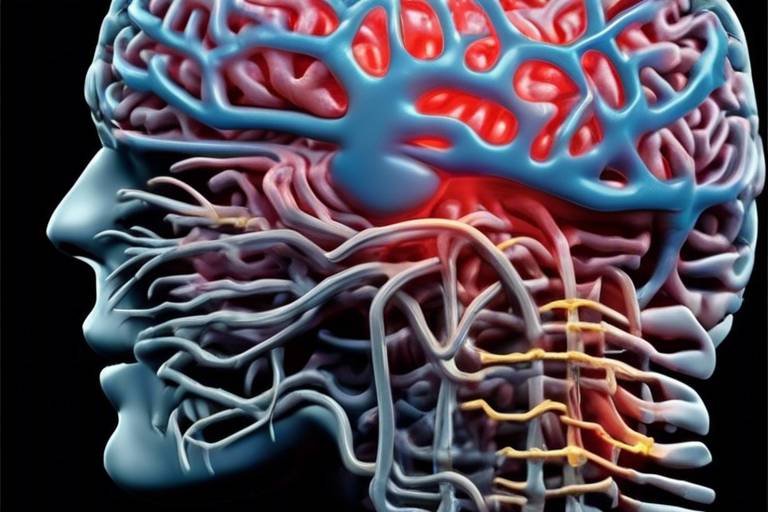The Latest Research on Air Quality and Public Health
In recent years, the connection between air quality and public health has become a hot topic, igniting discussions among scientists, policymakers, and the general public. With urbanization on the rise and industrial activities booming, understanding how air pollutants affect our health has never been more crucial. Research indicates that the air we breathe can significantly influence our well-being, leading to both short-term and long-term health issues. This article delves into the latest findings surrounding air quality, examining various pollutants, their sources, and the implications for policy and individual health.
The significance of clean air cannot be overstated. It is not just a luxury; it is a fundamental necessity for a healthy life. Imagine stepping outside on a crisp morning, inhaling deeply, and feeling invigorated by the fresh air. Now, picture the opposite scenario, where every breath you take is tainted by harmful particles and toxic gases. This stark contrast highlights the importance of understanding air quality and its direct impact on public health.
As we explore the intricacies of air quality, we must consider the various pollutants that lurk in our atmosphere. From particulate matter (PM) to nitrogen dioxide (NO2), each pollutant has its own set of characteristics and health implications. For instance, particulate matter, which consists of tiny particles that can penetrate deep into the lungs, is known to trigger respiratory problems and exacerbate existing health conditions. On the other hand, nitrogen dioxide, primarily emitted from vehicles and industrial processes, is linked to increased asthma attacks and other respiratory issues.
Understanding the origins of these pollutants is essential for tackling air quality issues effectively. Many pollutants originate from human activities, such as transportation, industrial emissions, and agricultural practices. However, natural sources like wildfires and volcanic eruptions also contribute to air pollution. By identifying these sources, we can better strategize to mitigate their impact on our health and environment.
In summary, the latest research underscores the critical relationship between air quality and public health. As we continue to uncover the effects of various pollutants, it becomes increasingly clear that improving air quality is not just an environmental issue; it is a public health imperative. Through collective efforts and informed policies, we can strive toward a healthier future for all.
Air pollutants come from various sources and can significantly impact health. This section will discuss common pollutants, their origins, and how they affect air quality.
Exposure to air pollution can lead to numerous health issues. Here, we will explore the short-term and long-term health effects of poor air quality on different populations.
Certain demographics are more susceptible to the effects of air pollution. This subsection highlights groups at higher risk, including children, the elderly, and those with pre-existing health conditions.
Children's developing bodies are particularly vulnerable to air pollution. We will examine how exposure can affect their growth and long-term health outcomes.
Older adults often face increased respiratory problems due to air pollution. This section discusses the specific challenges they encounter and potential mitigation strategies.
Chronic exposure to air pollutants can lead to severe health issues. This part will detail the long-term effects, including cardiovascular diseases and respiratory conditions.
Effective policies are essential for improving air quality. This section discusses current regulations, potential changes, and recommendations for policymakers to enhance public health.
Various countries are implementing initiatives to combat air pollution. We will explore successful global efforts and their impact on public health and air quality.
Local communities can make significant changes to improve air quality. This subsection outlines actionable steps individuals and local governments can take to mitigate pollution.
Q: What are the main sources of air pollution?
A: The main sources of air pollution include transportation, industrial emissions, and agricultural activities, as well as natural events such as wildfires.
Q: How does air pollution affect children's health?
A: Children are more vulnerable to air pollution as it can hinder their lung development and increase the risk of asthma and other respiratory diseases.
Q: What can individuals do to improve air quality?
A: Individuals can contribute by using public transport, reducing energy consumption, and supporting local initiatives aimed at reducing pollution.

Understanding Air Pollutants
Air quality is a crucial aspect of our environment, and understanding the pollutants that compromise it is essential for safeguarding public health. Air pollutants can be broadly categorized into two groups: primary pollutants, which are emitted directly from a source, and secondary pollutants, which form in the atmosphere through chemical reactions. Some common examples of these pollutants include:
- Particulate Matter (PM): Tiny particles suspended in the air, PM can penetrate deep into the lungs and even enter the bloodstream, causing serious health issues.
- Nitrogen Dioxide (NO2): Primarily produced from vehicle emissions and industrial activities, this gas can irritate the respiratory system and exacerbate asthma.
- Ozone (O3): While it occurs naturally in the upper atmosphere, ground-level ozone is a harmful pollutant formed by the reaction of sunlight with pollutants like volatile organic compounds (VOCs).
- Carbon Monoxide (CO): This colorless, odorless gas is produced by incomplete combustion of fossil fuels and can be particularly dangerous in enclosed spaces.
- Sulfur Dioxide (SO2): Emitted from power plants and industrial facilities, SO2 can lead to respiratory problems and contribute to acid rain.
Each of these pollutants originates from various sources, including transportation, industry, and even natural events like wildfires and volcanic eruptions. For instance, transportation is a major contributor to nitrogen dioxide and particulate matter, while industrial processes are significant sources of sulfur dioxide and VOCs. Understanding where these pollutants come from helps us identify strategies to reduce their emissions and improve air quality.
Moreover, the impact of these pollutants on air quality is not just a matter of environmental concern; it directly affects our health. For example, areas with high levels of particulate matter often see increased rates of respiratory diseases, heart conditions, and even premature death. The relationship between air quality and health is a complex web, where the type and concentration of pollutants play critical roles.
In conclusion, understanding air pollutants is essential for both individuals and policymakers. By recognizing the sources and health impacts of these pollutants, we can take informed steps toward improving air quality and protecting public health. As we delve deeper into the health effects of air pollution, we will uncover the specific vulnerabilities of different populations and explore potential solutions.

The Health Effects of Air Pollution
When we think about air pollution, it’s easy to picture smoggy cities or hazy skies. However, the real story lies in how these invisible pollutants infiltrate our lives and impact our health. Exposure to air pollution can lead to a myriad of health issues, ranging from mild irritations to severe chronic diseases. It's not just about the air we breathe; it's about the quality of life we lead. So, what exactly happens when we inhale polluted air?
Short-term exposure to air pollutants can trigger immediate health problems. For instance, individuals may experience respiratory symptoms such as coughing, wheezing, or shortness of breath. These effects can be particularly pronounced during high pollution days when the air quality index (AQI) spikes. On the other hand, long-term exposure to air pollution can have more insidious effects, leading to chronic health conditions that may not manifest until years later. This is where the real danger lies, as many people may not even realize they're being affected until significant damage has been done.
Some of the most common pollutants include:
- Particulate Matter (PM2.5 and PM10): Tiny particles that can penetrate deep into the lungs and even enter the bloodstream.
- Nitrogen Dioxide (NO2): Often produced from vehicle emissions, it can exacerbate respiratory diseases.
- Ozone (O3): While beneficial in the upper atmosphere, ground-level ozone can irritate the lungs and harm overall health.
The health implications of these pollutants are profound. Studies have shown that chronic exposure can lead to serious conditions such as cardiovascular diseases, lung cancer, and chronic obstructive pulmonary disease (COPD). Moreover, air pollution has been linked to increased rates of asthma, especially among children and the elderly, who are often more vulnerable due to their developing or weakened respiratory systems.
Speaking of vulnerability, certain demographics are at a heightened risk when it comes to the effects of air pollution. Children, for instance, are particularly susceptible due to their developing lungs and higher rates of outdoor activity. They breathe in more air relative to their body weight compared to adults, which makes them prime targets for the harmful effects of air pollutants. Similarly, the elderly often face increased respiratory issues, as their lungs may not function as effectively as they once did. Those with pre-existing health conditions, such as asthma or heart disease, are also at greater risk, making the fight against air pollution not just a matter of environmental concern, but a critical public health issue.
Imagine a child playing outside, laughing and running around, completely unaware of the invisible dangers lurking in the air. Unfortunately, this is the reality for many children living in polluted areas. Research indicates that exposure to air pollution during childhood can lead to long-term health consequences, including impaired lung development and increased susceptibility to respiratory infections. The stakes are high, and as a society, we must prioritize the protection of our youngest members.
For older adults, the implications of poor air quality can be even more dire. As we age, our respiratory systems naturally weaken, making it harder to combat the effects of pollution. Many elderly individuals already suffer from chronic conditions that can be exacerbated by polluted air, leading to a vicious cycle of health decline. It’s essential for communities to recognize these challenges and implement strategies that can help mitigate the impact of air pollution on this vulnerable population.
In summary, the health effects of air pollution are both immediate and long-lasting. From respiratory irritation to chronic diseases, the consequences are far-reaching. As we continue to uncover the links between air quality and health, it becomes increasingly clear that improving air quality is not just an environmental concern but a pressing public health issue that affects us all.
- What are the main sources of air pollution? Major sources include vehicle emissions, industrial discharges, and household activities such as burning fossil fuels.
- How can I protect myself from air pollution? Staying indoors on high pollution days, using air purifiers, and wearing masks can help reduce exposure.
- What are the long-term effects of air pollution? Long-term exposure can lead to chronic respiratory diseases, cardiovascular issues, and even premature death.

Vulnerable Populations
When we talk about air pollution, it’s crucial to recognize that not everyone is affected equally. Certain groups of people are more vulnerable to the harmful effects of poor air quality. These include children, the elderly, and individuals with pre-existing health conditions. Understanding why these groups are at greater risk can help us advocate for better air quality measures and protective policies.
Children are particularly susceptible to the dangers of air pollution. Their lungs are still developing, and they breathe in more air per pound of body weight compared to adults. This means that even low levels of pollutants can have a significant impact on their health. Studies have shown that exposure to air pollution during childhood can lead to long-term respiratory issues, cognitive impairments, and even developmental delays. Imagine a child trying to run and play, but their lungs are struggling due to the air they breathe. It’s a heartbreaking reality that many face.
Meanwhile, the elderly population also faces unique challenges. As we age, our bodies naturally become less resilient. Older adults often have pre-existing health conditions such as heart disease or chronic respiratory illnesses, making them more vulnerable to the adverse effects of air pollution. For example, fine particulate matter (PM2.5) can exacerbate asthma and lead to serious complications such as heart attacks or strokes. It’s like adding fuel to a fire; their already weakened systems can’t handle the extra burden.
Moreover, individuals with pre-existing health conditions, such as asthma, diabetes, or cardiovascular diseases, are at a heightened risk when exposed to polluted air. The pollutants can trigger severe symptoms or complications, leading to increased hospital visits and a decline in overall health. This creates a vicious cycle where poor air quality leads to health issues, which in turn makes individuals even more susceptible to the adverse effects of pollution.
To better illustrate the disparities in vulnerability, consider the following table that outlines the different groups and their specific risks:
| Population Group | Specific Risks |
|---|---|
| Children | Respiratory issues, cognitive impairments, developmental delays |
| The Elderly | Exacerbation of chronic diseases, increased risk of heart attacks and strokes |
| Individuals with Pre-existing Conditions | Severe symptoms, increased hospital visits, decline in health |
In conclusion, acknowledging the vulnerabilities of these populations is essential for developing effective strategies to combat air pollution. By focusing on these groups, we can tailor interventions that not only protect their health but also promote a cleaner environment for everyone. After all, everyone deserves to breathe clean air, don’t you think?
- Why are children more affected by air pollution?
Children's lungs are still developing, and they breathe more air relative to their body weight, making them more susceptible to pollutants. - What can be done to protect vulnerable populations from air pollution?
Advocating for stricter air quality regulations, increasing green spaces, and promoting public awareness can help protect these groups. - How does air pollution affect the elderly specifically?
Older adults often have existing health conditions that can be worsened by air pollution, leading to serious health complications.

Children and Air Quality
When it comes to air quality, children are among the most vulnerable populations. Their bodies are still developing, which means that exposure to pollutants can have lasting effects on their health. Imagine a young tree growing in a polluted environment; just like that tree, a child's growth can be stunted by the harmful elements in the air they breathe. Studies show that children who are regularly exposed to poor air quality may experience a range of health issues, from respiratory illnesses to cognitive impairments.
One of the primary concerns is that children's lungs are still developing. This makes them more susceptible to the effects of air pollution, particularly from particulate matter and ozone. These pollutants can lead to chronic respiratory conditions such as asthma, which has seen a significant rise in prevalence among children in urban areas. According to the World Health Organization, approximately one in ten children worldwide suffers from asthma, and poor air quality is a major contributing factor.
Furthermore, exposure to air pollution during critical developmental stages can impact a child's neurological development. Research indicates that children living in areas with high levels of air pollution may face challenges in cognitive function, leading to difficulties in learning and memory. This can have a ripple effect, influencing their academic performance and overall quality of life. It's alarming to think that the very air we breathe could be hindering the potential of our future generations.
To illustrate the impact of air quality on children, let's look at some common air pollutants and their specific effects:
| Pollutant | Source | Health Effects |
|---|---|---|
| Particulate Matter (PM2.5) | Vehicle emissions, industrial discharges | Respiratory issues, reduced lung function |
| Ozone (O3) | Sunlight reacting with pollutants | Worsened asthma, throat irritation |
| Nitrogen Dioxide (NO2) | Burning fossil fuels, vehicle exhaust | Increased susceptibility to respiratory infections |
It's crucial for parents and caregivers to be aware of these risks and take proactive steps to protect children from exposure to harmful air pollutants. Simple actions can make a significant difference, such as:
- Keeping windows closed on days with high pollution levels.
- Using air purifiers indoors to improve air quality.
- Encouraging outdoor play during times when air quality is better, such as early morning or late evening.
In conclusion, the implications of air quality on children's health are profound and multifaceted. As a society, we must prioritize clean air initiatives and advocate for policies that protect our youngest and most vulnerable citizens. After all, ensuring that our children grow up in a healthy environment is not just a responsibility; it's an investment in our collective future.
Q: How can I find out about local air quality levels?
A: You can check local air quality reports through websites like AirNow or your local environmental agency. Many cities also provide real-time air quality updates through apps.
Q: What are some signs that my child may be affected by poor air quality?
A: Look for symptoms such as persistent coughing, wheezing, shortness of breath, or frequent respiratory infections. If you notice these signs, consult a healthcare professional.
Q: Are there specific times when air quality is worse?
A: Yes, air quality can be poorer during certain times of the day, especially during rush hour when traffic is heavy, or on hot sunny days when ozone levels rise. Monitoring forecasts can help you plan outdoor activities.

The Elderly and Respiratory Issues
As we age, our bodies undergo various changes that can make us more susceptible to health issues, particularly when it comes to respiratory problems. For many elderly individuals, the air we breathe can become a silent foe, wreaking havoc on their already fragile health. Respiratory issues, exacerbated by poor air quality, can lead to a decline in overall well-being and quality of life. But what exactly makes the elderly more vulnerable to these air pollutants?
One major factor is the natural decline in lung function that occurs with age. The lungs become less efficient at filtering out harmful particles, which means that even lower levels of pollution can have a profound impact. Additionally, many older adults may have pre-existing conditions such as asthma, chronic obstructive pulmonary disease (COPD), or cardiovascular issues, which can be aggravated by exposure to pollutants like particulate matter, nitrogen dioxide, and sulfur dioxide.
Furthermore, the elderly often spend more time indoors, where indoor air quality can be just as concerning as outdoor pollution. Sources of indoor air pollution, such as tobacco smoke, mold, and dust, can contribute to respiratory distress. As a result, older adults may experience symptoms like shortness of breath, coughing, and wheezing, which can further limit their activity levels and independence.
To illustrate the connection between air quality and respiratory health in the elderly, consider the following table that outlines common pollutants and their potential effects:
| Pollutant | Source | Health Effects |
|---|---|---|
| Particulate Matter (PM2.5) | Vehicle emissions, industrial processes | Aggravates asthma, COPD, and heart disease |
| Nitrogen Dioxide (NO2) | Burning of fossil fuels, gas stoves | Increases risk of respiratory infections |
| Ozone (O3) | Sunlight reacting with pollutants | Causes chest pain, throat irritation, and worsens lung diseases |
Given these risks, it's crucial for caregivers and family members to be aware of the environmental factors affecting the elderly. Simple steps can be taken to improve their air quality, such as using air purifiers, ensuring proper ventilation, and avoiding exposure to tobacco smoke. Moreover, regular health check-ups can help monitor any respiratory issues that may arise, allowing for timely intervention.
In summary, the interplay between aging and air quality is a pressing concern that demands attention. By understanding how air pollution affects the respiratory health of the elderly, we can take proactive measures to safeguard their health and enhance their quality of life. After all, clean air is not just a luxury; it's a necessity for everyone, especially our senior citizens who deserve to breathe easy.
- What are the most common respiratory issues in the elderly? Conditions such as asthma, COPD, and pneumonia are prevalent among older adults.
- How can I improve indoor air quality for an elderly person? Consider using air purifiers, keeping windows open for ventilation, and avoiding strong odors from cleaning products.
- What should I do if an elderly person shows symptoms of respiratory distress? Seek medical attention immediately if symptoms like difficulty breathing or persistent cough occur.

Long-Term Health Consequences
Chronic exposure to air pollutants is not just a fleeting issue; it can lead to severe and often irreversible health consequences. Imagine living in a city where the air is thick with smog, and every breath you take feels like you're inhaling tiny shards of glass. This is the reality for millions around the world, and the long-term effects of such exposure are alarming. Studies have shown that individuals who breathe polluted air over extended periods are at a significantly increased risk of developing serious health conditions, including cardiovascular diseases, respiratory disorders, and even certain types of cancer.
For instance, research indicates that particulate matter (PM2.5), which is a common air pollutant, can penetrate deep into the lungs and enter the bloodstream. This can lead to chronic inflammation and has been linked to diseases such as asthma and chronic obstructive pulmonary disease (COPD). The World Health Organization (WHO) reports that air pollution is responsible for approximately 7 million premature deaths each year, highlighting the urgency of addressing this public health crisis.
Furthermore, the impact of air pollution isn't uniform across the population. Various studies have shown that long-term exposure can exacerbate pre-existing conditions, leading to a vicious cycle of health deterioration. For example, individuals with asthma may find their symptoms worsening due to increased air pollution, which in turn leads to more frequent hospital visits and a decreased quality of life.
In addition to respiratory and cardiovascular issues, emerging research suggests a potential link between air pollution and neurological disorders. Some studies have even indicated that long-term exposure to polluted air might contribute to cognitive decline and an increased risk of diseases like Alzheimer’s. The implications are staggering: as urban areas continue to grow and pollution levels rise, we may be facing a public health crisis that extends beyond the physical realm and into our mental well-being.
To put things into perspective, let's take a look at a table that summarizes some of the key long-term health effects associated with common air pollutants:
| Pollutant | Health Effects |
|---|---|
| Particulate Matter (PM2.5) | Increased risk of heart disease, lung cancer, and respiratory illnesses. |
| Nitrogen Dioxide (NO2) | Worsening asthma, reduced lung function, and increased respiratory infections. |
| Ozone (O3) | Exacerbation of asthma, reduced lung function, and increased hospital admissions for respiratory issues. |
| Sulfur Dioxide (SO2) | Respiratory problems and increased risk of cardiovascular diseases. |
In conclusion, the long-term health consequences of air pollution are profound and far-reaching. It's not just about the immediate discomfort of a cough or a sore throat; it's about a lifetime of health implications that can significantly alter the trajectory of an individual's well-being. As we continue to learn more about these effects, it becomes increasingly clear that tackling air pollution is not merely an environmental issue but a fundamental public health challenge that demands immediate action.
- What are the main sources of air pollution? Common sources include vehicle emissions, industrial discharges, and burning fossil fuels.
- How can I protect myself from air pollution? Staying indoors on high pollution days, using air purifiers, and wearing masks can help reduce exposure.
- What are the symptoms of air pollution exposure? Symptoms can include coughing, shortness of breath, throat irritation, and fatigue.
- Are children more affected by air pollution? Yes, children are particularly vulnerable due to their developing respiratory systems.
- What can governments do to improve air quality? Governments can implement stricter emissions regulations, promote public transportation, and invest in renewable energy sources.

Policy Implications and Recommendations
As we delve into the intricate relationship between air quality and public health, it's crucial to recognize that effective policies are the backbone of any successful strategy aimed at mitigating the adverse effects of air pollution. The findings from recent research underscore the urgent need for comprehensive regulations that not only address current air quality issues but also anticipate future challenges. With air pollution being a multifaceted problem, a one-size-fits-all approach simply won't cut it. Instead, tailored solutions that consider local conditions, sources of pollution, and community needs are essential.
One of the most pressing policy implications is the need for stricter regulations on emissions from industrial sources and vehicles. Many urban areas are grappling with high levels of particulate matter and nitrogen oxides, primarily due to traffic and industrial activities. Implementing emission standards that are both stringent and enforceable can lead to significant improvements in air quality. For instance, cities that have adopted low-emission zones have seen a marked decrease in pollutants, showcasing the effectiveness of targeted regulations.
Moreover, public awareness campaigns play a vital role in shaping community behavior towards air quality. Educating the public about the sources and effects of air pollution can empower individuals to make informed choices. For example, initiatives that promote the use of public transportation, cycling, and walking can significantly reduce vehicular emissions. As a result, local governments should invest in outreach programs and partnerships with schools and community organizations to foster a culture of sustainability.
To illustrate the impact of policy changes, let's look at some successful global initiatives aimed at improving air quality:
| Country | Initiative | Impact |
|---|---|---|
| China | Air Pollution Prevention and Control Action Plan | Reduced PM2.5 levels by over 30% in major cities |
| United Kingdom | Clean Air Strategy | Significant reduction in nitrogen dioxide levels |
| India | National Clean Air Programme | Targeted reduction of particulate matter in 122 cities |
These examples highlight that when governments take decisive action, the results can be transformative. However, local actions are equally important. Community-level initiatives can often lead to substantial improvements in air quality. Local governments can implement measures such as increasing green spaces, promoting energy-efficient public transportation systems, and encouraging the use of renewable energy sources. Additionally, individuals can contribute by reducing their carbon footprint through simple actions like carpooling, using energy-efficient appliances, and supporting local clean air initiatives.
In conclusion, the implications of air quality on public health cannot be overstated. Policymakers must prioritize the development and enforcement of regulations that protect our air. By combining national strategies with local actions, we can create a healthier environment for everyone. The path to cleaner air is a collaborative effort that requires the commitment of individuals, communities, and governments alike.
- What are the main sources of air pollution? Common sources include vehicle emissions, industrial discharges, and household activities.
- How can I improve air quality in my home? Use air purifiers, avoid smoking indoors, and ensure proper ventilation.
- What are the health effects of poor air quality? Short-term effects include respiratory issues, while long-term exposure can lead to chronic diseases like asthma and heart disease.

Global Initiatives
In recent years, the urgency to combat air pollution has spurred a plethora of aimed at improving air quality and, consequently, public health. Countries around the world are recognizing that clean air is not just a luxury, but a fundamental right. For instance, the World Health Organization (WHO) has been at the forefront, setting guidelines and encouraging nations to adhere to stricter air quality standards. This international effort is akin to a global orchestra, where each nation plays its part to create a harmonious environment.
One standout initiative is the United Nations Environment Programme (UNEP), which launched the Air Quality Initiative aimed at raising awareness and providing tools for countries to monitor and improve their air quality. Countries like India and China have implemented stringent measures to curb emissions from industries and vehicles, showcasing a significant commitment to cleaner air. For example, in China, the government has invested heavily in renewable energy sources, which not only reduces air pollutants but also contributes to a sustainable future.
Moreover, the European Union has established the Clean Air for Europe (CAFE) program, which seeks to improve air quality across member states through comprehensive legislation and monitoring. The program is a testament to how collaboration can lead to impactful change. By sharing data and best practices, countries can learn from one another and implement effective strategies tailored to their unique challenges.
In addition to these large-scale initiatives, grassroots movements are also making waves. Local communities are taking it upon themselves to advocate for cleaner air. Initiatives like “No More Pollution” campaigns have gained traction, urging citizens to reduce vehicle use and promote public transportation. These community-driven efforts highlight the importance of individual actions in the larger fight against air pollution.
To illustrate the impact of these global initiatives, let’s take a look at a table summarizing some key programs and their outcomes:
| Initiative | Region | Key Focus | Outcome |
|---|---|---|---|
| WHO Air Quality Guidelines | Global | Setting air quality standards | Improved compliance by member nations |
| UNEP Air Quality Initiative | Global | Monitoring and awareness | Increased national air quality assessments |
| Clean Air for Europe (CAFE) | European Union | Legislation and monitoring | Reduction in particulate matter levels |
| Local “No More Pollution” Campaigns | Various | Community engagement | Increased public transport usage |
As we can see, the collective efforts of nations and communities are paving the way for a cleaner, healthier future. However, the journey is far from over. Continuous engagement and commitment are essential to sustain these initiatives and ensure that the air we breathe is safe for everyone. The question remains: what more can we do to support these global efforts? As individuals, we can advocate for policies that prioritize air quality and hold our governments accountable. Together, we can make a difference!
- What are the main sources of air pollution? Common sources include vehicle emissions, industrial discharges, and agricultural activities.
- How does air pollution affect health? Exposure can lead to respiratory diseases, cardiovascular issues, and other serious health problems.
- What can individuals do to help improve air quality? Individuals can reduce their carbon footprint by using public transportation, supporting clean energy initiatives, and advocating for stronger environmental policies.

Local Actions for Improvement
When it comes to tackling the pressing issue of air quality, local communities hold the key to driving change. It’s like the old saying goes: “Think globally, act locally.” While global initiatives are crucial, the power of grassroots movements cannot be underestimated. By taking small, actionable steps, communities can significantly improve air quality and, in turn, public health. So, what can be done at the local level? Let’s dive into some practical actions that can be implemented.
First and foremost, community engagement is essential. Local residents should be encouraged to participate in air quality monitoring programs. This not only raises awareness but also helps gather valuable data on pollution sources. For instance, organizing clean-up days can engage the community while addressing litter that contributes to poor air quality. Imagine a neighborhood coming together, armed with trash bags and a shared goal of a cleaner environment. It’s not just about picking up trash; it’s about fostering a sense of community and responsibility.
Moreover, local governments can implement policies that promote sustainable transportation options. Encouraging walking, biking, and the use of public transportation can drastically reduce vehicle emissions. For example, creating bike lanes and pedestrian-friendly pathways can make these options more appealing. Additionally, cities can establish carpool programs or incentivize the use of electric vehicles through tax breaks or charging station installations. The goal is to create an environment where clean transportation is the norm, not the exception.
Another effective action is to advocate for green spaces. Urban areas often suffer from a lack of vegetation, which can exacerbate air pollution. Planting trees and creating parks can serve multiple purposes: they improve air quality by absorbing pollutants, provide shade, and enhance the aesthetic appeal of the neighborhood. Plus, they offer a natural habitat for wildlife. It’s a win-win situation! Communities can organize tree-planting events, partnering with local schools and organizations to instill a sense of environmental stewardship in younger generations.
Furthermore, local businesses can play a pivotal role in improving air quality. By adopting sustainable practices, such as using eco-friendly materials and reducing waste, they can set a positive example for the community. Local governments can support these initiatives through grants or recognition programs that highlight businesses committed to sustainability. Imagine walking through a neighborhood where every shop proudly displays its commitment to clean air. It creates a culture of health and environmental consciousness.
Finally, education and outreach are paramount. Schools, community centers, and local organizations should provide resources and workshops on air quality and its impact on health. By educating residents about the sources of pollution and how to reduce their carbon footprint, communities empower individuals to make informed choices. This could include simple actions, such as using energy-efficient appliances or reducing indoor air pollution by choosing non-toxic cleaning products.
In summary, local actions for improving air quality are not just about policy changes; they encompass community engagement, sustainable transportation, green spaces, business practices, and education. Each small step contributes to a larger movement toward cleaner air and healthier lives. As we take these steps together, we can create a ripple effect that leads to significant improvements in air quality, benefiting everyone in the community.
- What are some simple actions I can take to improve air quality in my community?
Start by reducing vehicle use, participating in local clean-up events, and advocating for more green spaces. - How can local businesses contribute to better air quality?
They can adopt eco-friendly practices, reduce waste, and engage in community sustainability initiatives. - Why is education important for improving air quality?
Education raises awareness about pollution sources and empowers individuals to make healthier choices.
Frequently Asked Questions
-
What are the main air pollutants that affect public health?
Air pollutants come in various forms, but the most common include particulate matter (PM), nitrogen dioxide (NO2), sulfur dioxide (SO2), and ozone (O3). These pollutants can originate from vehicle emissions, industrial processes, and even natural sources like wildfires. Understanding these pollutants is crucial because they can lead to serious health issues.
-
How does air pollution impact vulnerable populations?
Certain groups, such as children, the elderly, and individuals with pre-existing health conditions, are more susceptible to the harmful effects of air pollution. For example, children’s lungs are still developing, making them particularly vulnerable to respiratory issues. Similarly, older adults often experience exacerbated respiratory problems due to long-term exposure to poor air quality.
-
What are the short-term health effects of poor air quality?
Short-term exposure to air pollution can lead to symptoms like coughing, throat irritation, and shortness of breath. It can also trigger asthma attacks and other respiratory conditions. These immediate effects can significantly impact daily activities and overall quality of life.
-
What long-term health consequences can arise from chronic exposure to air pollution?
Chronic exposure to air pollutants can result in severe health issues such as cardiovascular diseases, chronic respiratory conditions, and even lung cancer. The cumulative effects of poor air quality over time can lead to diminished health and increased mortality rates.
-
What policies are currently in place to address air quality issues?
Various regulations exist to tackle air pollution, including the Clean Air Act in the United States, which sets standards for air quality. However, there’s always room for improvement, and policymakers are encouraged to consider stricter regulations and innovative solutions to enhance public health.
-
How can individuals contribute to improving air quality?
Individuals can take several actionable steps, such as using public transportation, reducing energy consumption, and supporting local green initiatives. Every small effort counts, and collective action can lead to significant improvements in air quality.
-
Are there any global initiatives aimed at reducing air pollution?
Yes, many countries are implementing global initiatives to combat air pollution. Programs like the WHO’s Global Air Quality Guidelines aim to provide countries with frameworks to improve air quality and protect public health. These initiatives often lead to collaborative efforts that yield positive outcomes.



















